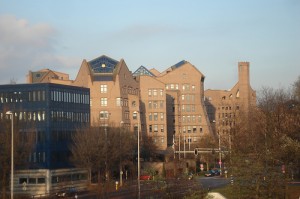Typically characterized as hard, or cold. This, too, is one of the loaded meanings of green, of course, and not keeping some handle on it would be not only remiss but cause the other meanings to crash into a field of mere literal connotations. In that spirit, this article in the Times on the Museum of Contemporary Art in Los Angeles caught my, um, eye.
So first thing, the headline, Soaring in Art, Museum Trips over Finances, doesn’t past the smell test. You should know something is awry when art and finance are used in the same phrase in a newspaper. And not because anything is sacred, fer chrissakes. But finance in newspapers always means shareholders and art, alas, can’t even get its mouthpiece in before the first haymaker.
And sure enough, a couple of graphs in, the MOCA is in trouble – and has been for years. Bad management, shrinking endowment used for operational expenses, big donors bolting the board… I’m being redundant.
Yet by putting art ahead of the bottom line, the Museum of Contemporary Art has nearly killed itself. The museum has operated at a deficit in six of the last eight years, and its endowment has shrunk to about $6 million from nearly $50 million in 1999, according to people who have been briefed on the finances.
So, contemporary art… what have they been showing? Their permanent collection boasts Rauschenberg and Ruscha, but money problems at museums make me think of much more complexicated™ interstices of art, marketing and commodity than mere paintings, printmaking or collage. What’s the word… oh yes… Installation. And sure enough they get to it.
And at times the museum has secured financing for exhibitions in ways that many other museums would shun. To help pay for last year’s Takashi Murakami exhibition, the museum solicited hundreds of thousands of dollars in donations from art galleries that represented the artist and therefore stood to gain from any related career boost.
Fair enough, I actually see little wrong with this supposedly nefarious ploy, as if our shackles should rise merely on the cross-branding. I mean, where is the lost innocence? No, I’m much more interested in who and what is Takashi Murakami. And a .0002567-second interweb search brings video of the Times coverage of his exib at the Brooklyn Museum last year. Murakami, a Japanese pop artist likened by the video reporter to Andy Warhol because “he works at the intersection of pop art, mass design and high fashion.” Excellent.
He’s known for his work – there’s that word again – with Louis Vuitton; in fact there was a functioning LV boutique inside the museum. What’s that game? Oh yeah. Keno!
But let’s go to the man himself. Reporter: do you think a purse with a logo on it can be considered art work? (Don’t answer that. She’s trying to trick…)
Murakami: I think so.
Okay, okay. LV creative director Marc Jacobs makes the point that art is fundamentally unnecessary, that “with art, there is no right or wrong, only opinions.” The extent to which he actually believes this confirms the self-fulfilling nature of his point.
So back to the financial problems at the LA museum. Alternately, there could have been some sort of foundational flaw in the building itself to cause it to physically collapse and everyone would stand around the pile of rubble lamenting the decision to go with the architect who fathered the structural imperfection, signed off on the drawings that ultimately destroyed what they were designed to protect. “People deserve better!” the elegantly appointed mob might chant.
Instead, it is teetering on the verge of a similar collapse because of what? Some design flaw that reinforces how unnecessary it is? In the post-judgment judgment environment, if art or ecology can be mixed with commerce, then they must be. It seems to be the only rule. So let’s no kid ourselves about the consequences.
But discerning what it is and is not necessary is all about one of these. Can you guess which?

